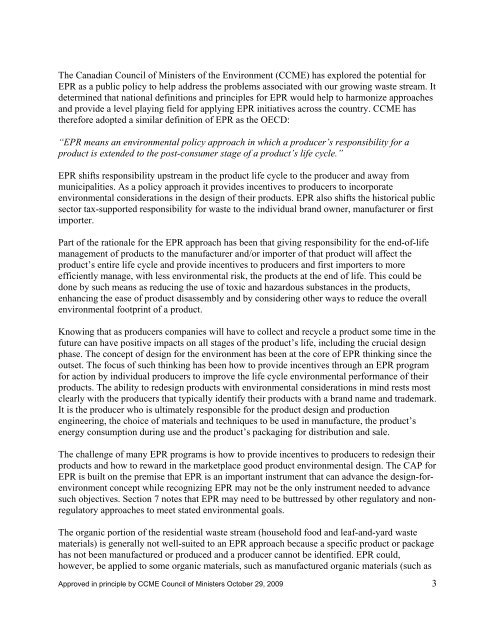Canada-Wide Action Plan for Extended Producer ... - CCME
Canada-Wide Action Plan for Extended Producer ... - CCME
Canada-Wide Action Plan for Extended Producer ... - CCME
Create successful ePaper yourself
Turn your PDF publications into a flip-book with our unique Google optimized e-Paper software.
The Canadian Council of Ministers of the Environment (<strong>CCME</strong>) has explored the potential <strong>for</strong><br />
EPR as a public policy to help address the problems associated with our growing waste stream. It<br />
determined that national definitions and principles <strong>for</strong> EPR would help to harmonize approaches<br />
and provide a level playing field <strong>for</strong> applying EPR initiatives across the country. <strong>CCME</strong> has<br />
there<strong>for</strong>e adopted a similar definition of EPR as the OECD:<br />
“EPR means an environmental policy approach in which a producer’s responsibility <strong>for</strong> a<br />
product is extended to the post-consumer stage of a product’s life cycle.”<br />
EPR shifts responsibility upstream in the product life cycle to the producer and away from<br />
municipalities. As a policy approach it provides incentives to producers to incorporate<br />
environmental considerations in the design of their products. EPR also shifts the historical public<br />
sector tax-supported responsibility <strong>for</strong> waste to the individual brand owner, manufacturer or first<br />
importer.<br />
Part of the rationale <strong>for</strong> the EPR approach has been that giving responsibility <strong>for</strong> the end-of-life<br />
management of products to the manufacturer and/or importer of that product will affect the<br />
product’s entire life cycle and provide incentives to producers and first importers to more<br />
efficiently manage, with less environmental risk, the products at the end of life. This could be<br />
done by such means as reducing the use of toxic and hazardous substances in the products,<br />
enhancing the ease of product disassembly and by considering other ways to reduce the overall<br />
environmental footprint of a product.<br />
Knowing that as producers companies will have to collect and recycle a product some time in the<br />
future can have positive impacts on all stages of the product’s life, including the crucial design<br />
phase. The concept of design <strong>for</strong> the environment has been at the core of EPR thinking since the<br />
outset. The focus of such thinking has been how to provide incentives through an EPR program<br />
<strong>for</strong> action by individual producers to improve the life cycle environmental per<strong>for</strong>mance of their<br />
products. The ability to redesign products with environmental considerations in mind rests most<br />
clearly with the producers that typically identify their products with a brand name and trademark.<br />
It is the producer who is ultimately responsible <strong>for</strong> the product design and production<br />
engineering, the choice of materials and techniques to be used in manufacture, the product’s<br />
energy consumption during use and the product’s packaging <strong>for</strong> distribution and sale.<br />
The challenge of many EPR programs is how to provide incentives to producers to redesign their<br />
products and how to reward in the marketplace good product environmental design. The CAP <strong>for</strong><br />
EPR is built on the premise that EPR is an important instrument that can advance the design-<strong>for</strong>environment<br />
concept while recognizing EPR may not be the only instrument needed to advance<br />
such objectives. Section 7 notes that EPR may need to be buttressed by other regulatory and nonregulatory<br />
approaches to meet stated environmental goals.<br />
The organic portion of the residential waste stream (household food and leaf-and-yard waste<br />
materials) is generally not well-suited to an EPR approach because a specific product or package<br />
has not been manufactured or produced and a producer cannot be identified. EPR could,<br />
however, be applied to some organic materials, such as manufactured organic materials (such as<br />
Approved in principle by <strong>CCME</strong> Council of Ministers October 29, 2009 3
















